Mojo MORC 40 Crowns
Test Locations: WA, OR, & Northern CA
Duration of test: 5 months
Version Tested: Flat-top crown
Blister’s Measured Weight (including the preload bolt and all hardware): 598 g
Test Setup:
- Bike: Nicolai G16, Mojo Special Edition
- Fork: Fox 40 Float RC2
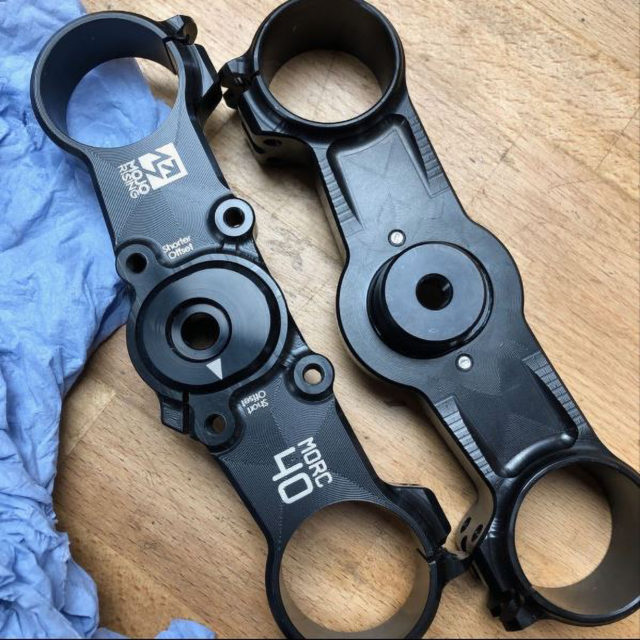
Intro
Chris Porter – founder of Mojo Suspension and Geometron Bikes – has long been in the vanguard of tinkering with mountain bike geometry. Last year, some non-standard crowns started appearing on the forks of a number of prominent Downhill racers riding Fox 40s, including the likes of Greg Minnaar, Loris Vergier, Matt Walker, and Gee Atherton.
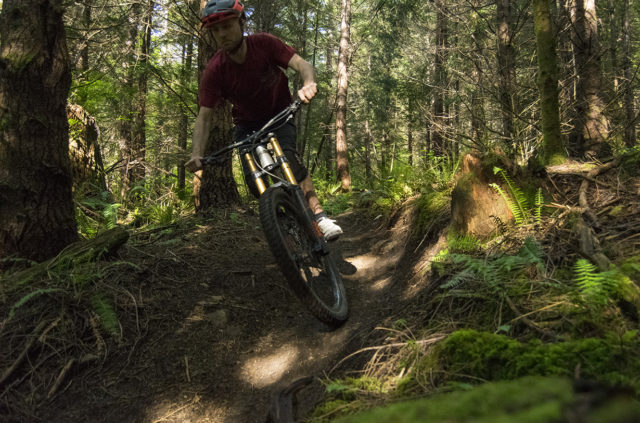
It turns out, those crowns were the MORC 40 (i.e. Mojo Offset Reducing Crowns), a new product from Porter’s Mojo Rising, designed to reduce the offset of the Fox 40, and are now available to the public. I’ve been testing a set, and have come away very impressed.
[If you haven’t already, you should probably stop right here and go read our Fork Offset 101 article as a primer for this one. The info in that article is going to be very useful here, particularly if you’re not familiar with fork offset and its effect on the handling of mountain bikes.]
What Mojo Says About the MORC 40 Crowns
“Mojo’s offset adjustable MORC crown system is now available for the F*x 40 fork. Whilst offset has been reduced to fine tune handling on enduro bikes, the DH bikes have been left in the past by the Fork manufacturers! Although some of the shorter offsets we see on single crown forks are compensating for the flex in the crown, the offsets on the DH forks are just old fashioned! Shorter offsets improve stability which allows the rider to push harder and more predictably in the rough and in the turns. Rather than ‘understeering’ into a berm, slowing down and pedaling out, the shorter offset allows the rider to lean and carve and hold speed through the turns.”
Most of that is consistent with my experience testing fork offsets, both with the MORC 40 and other fork combinations. I go into a lot more detail in the Fork Offset 101 article, but I very much agree that shorter-offset forks do help a bike lean over and arc into a higher-speed turn more naturally, and are more stable at higher speeds in rough terrain (all else being equal). The bit about single-crown flex is interesting, but it does stand to reason that the additional fore-aft flex that a single crown fork experiences would have some impact on mechanical trail by moving the contact point of the tire.
Design
The overall form of the MORC 40 is quite similar to the Fox 40’s stock crowns, but with two key differences. First, of course, the MORC 40 crowns shorten the offset of the fork, and second, they do this in part by dispensing with a normal steerer tube. Rather than using a conventional steerer tube that’s bonded to the lower crown, the MORC 40 uses two small stubs that attach to the upper and lower crowns, which are just long enough to support the upper and lower headset bearings, respectively.
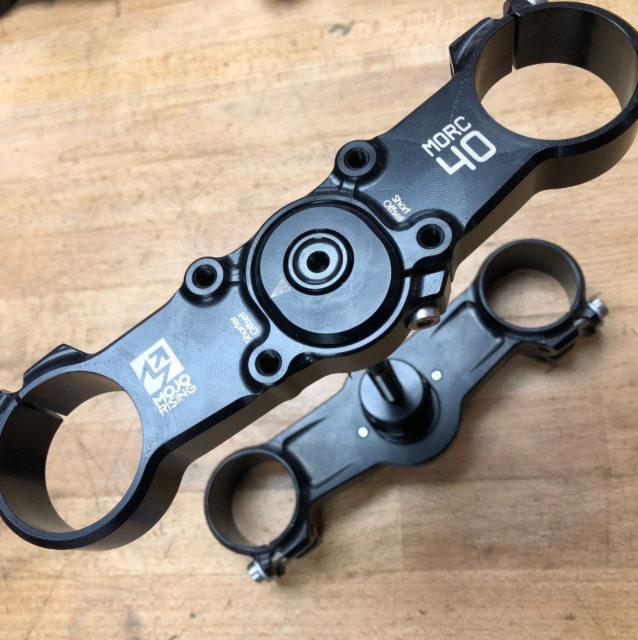
A long aluminum bolt runs through the headtube to tie the two together and preload the headset, but there’s no continuous steerer tube. These stubs are on eccentric “flip chips” and can be installed in two different orientations, labeled “Short Offset” and “Shorter Offset” on the upper crown; these reduce the fork’s offset by 3 and 8 mm, respectively.
That means that a 26” Fox 40 set up with the MORC 40 has either 37 or 42 mm of offset (stock is 45 mm), a 2020 or earlier 27.5” fork has 44 or 49 mm (from the stock 52 mm), and the 49 gets 50 or 55 mm, down from 58 mm.
The 2021 model year Fox 40 forks now have 48 mm and 52 mm of offset in stock guise for the 27.5” and 29” forks, respectively, but Fox achieved these offsets by greatly reducing the offset at the lowers, and increasing the offset at the crowns. The 27.5” and 29” forks now have the same offset in the lowers, but ship with different stock crowns, which were previously the same for all wheel sizes. The result is that a 2021 Fox 40 with the MORC crowns would have 37 or 42 mm of offset irrespective of wheel size.
The MORC 40 is available in two versions, with either a flat or dropped-top crown, to accommodate a range of headtube / headset stack heights; the preload bolt also comes in a range of lengths to match. Mojo says the flat crown suits a 110–130 mm total stack height, and the drop crown works for 110–145 mm. I ended up using the flat crown with a 132 mm total stack since the drop crown wasn’t available at the time of the review and had no issues, despite slightly exceeding the officially allowable range.

Of course, since there’s no steerer tube, the MORC 40 is only compatible with direct-mount stems. (But really, you’re not using a steerer-tube-mount stem on your 40, in 2020? Right?) Since the relationship between the “steerer tube,” such as it is, and the stanchions changes to toggle between the offset positions, they also wind up varying the stem length slightly; the “short” position of the MORC 40 lengthens the stem by 2.5 mm, and the “shorter” one shortens it by the same amount.
Installation and Fit
Installing the MORC 40 works just like putting the crowns on any other dual-crown fork. The lack of a steerer tube just means that the fork flops around a little more before you get the upper crown installed, but it’s not appreciably more difficult than with the stock crowns. In fact, in some ways, it’s easier.
Every stock dual crown fork I’ve ever worked on took a little bit of muscle to slide the upper crown on and off the stanchions. Not so with the MORC 40. Whether it’s due to tighter machining tolerances or the decreased demands of only having to line up the two stanchions, instead of two stanchions and the steerer tube, the MORC 40 glides right on effortlessly.
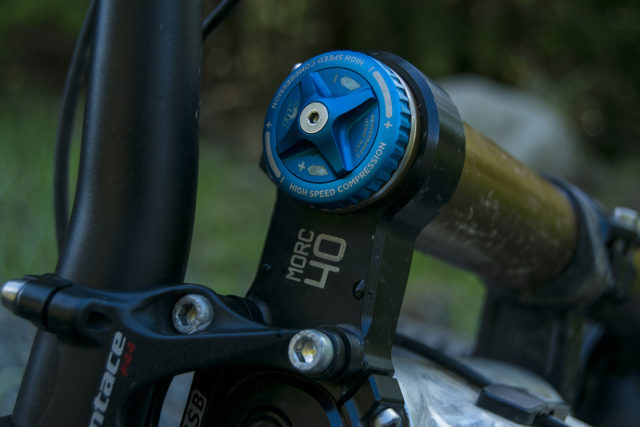
Toggling between the two offset positions does require taking the fork off the bike, but isn’t difficult. Just remove the crowns from the fork, loosen the pinch bolt holding the flip chip in the upper crown, then pull the flip chip out and reverse it. The lower flip chip fastens to the crown via two hex-head bolts from the underside of the crown; due to the extra clamping force it sees, the lower flip chip can be slightly prone to getting stuck. Mojo includes a plastic spacer that allows you to put the lower crown in a bench vice and press out the flip chip. If you don’t have one handy, a decent whack with a rubber mallet does the trick, too.
I was concerned that the extra metal-on-metal interfaces that the flip chips present might be prone to creaking, but to this point, that has proven to be unfounded. Despite riding the MORC 40 through a wet Washington winter, I haven’t heard a peep out of them.

The MORC 40 is also gorgeous. The machining is impeccable, the hardware well thought out (including some clever serrated washers on the stanchion clamp bolts), and everything fits together beautifully. The whole assembly gets a black anodized finish, with laser-etched Mojo logos and labels.
It is slightly heavier than the stock crown at 598 g for my set, likely due to the added complexity presented by the flip chips, but the difference is moderate. My stock crowns, with the steerer tube cut to length and including a star nut, weighs 503 grams. The MORC 40 does claw a little weight back since it doesn’t require a stem top cap and bolt, plus the weight of any spacers you might have above the top crown on the current setup, so the total weight gain is around 60-70 g.
On the Trail
The biggest – in fact, really the only – way the MORC 40 feels different than the stock crowns is in how reducing the offset impacts the handling of the bike. To be clear, that’s a good thing. Despite forgoing the steerer tube, I haven’t been able to detect any difference in stiffness between the MORC 40 and the stock crowns, and I haven’t noticed any issues with accelerated headset-bearing wear either.
I go into a lot more detail on the impacts to handling of changing fork offset in our Fork Offset 101 article – and, again, you should absolutely read that one if you’re interested enough to have made it this far. In short, the shorter offset offered by the MORC 40 improves stability at higher speeds, makes lean-in to initiate a turn smoother and more intuitive when going fast enough to do so, and helps the bike hold a line when smashing the front wheel into stuff.
All of these changes are perceptible with the MORC 40 in the “short” position. They’re far more obvious in the “shorter” one. A 3 mm change in offset is subtle – when fork manufacturers offer multiple offsets in the same model fork, the difference is usually in the 6-10 mm range between the options. The -8 mm “shorter” position makes all of these changes much more pronounced.
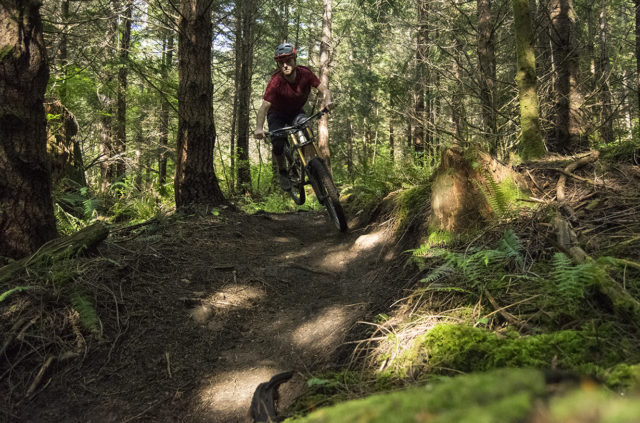
When first hopping on the bike after installing the MORC 40, the change to the steering feel at low speed is the most obviously apparent difference. The shorter offset makes the steering feel calmer and more stable near center (i.e. going straight) but floppier and harder to control when the bars are turned dramatically. The sensation takes a bit of getting used to at lower speeds, but I’ve found it fairly easy to adapt after a little time on the new setup, and some corresponding brain retraining.
Where reducing the offset feels clearly better is arcing into higher speed, sweeping turns. Especially on a bike like my Nicolai G16 with a long wheelbase and slack headtube angle (~62°, depending on setup), turning at speed involves a lot more leaning into the corner than it does actually turning the bars. In these situations, the shorter-offset fork feels noticeably smoother and more natural.
The shorter offset position does also make the steering less prone to getting deflected off line when running the front wheel into obstacles at speed, but this is one of the more subtle changes brought about by a change in offset; whether it makes much difference at all depends quite a bit on how and at what angle the impact comes from. Dramatically off-camber obstacles (think a tall, pronounced root that slopes downward across the trail) are where it’s most apparent, but compared to the changes in steering feel, this effect is far less pronounced in my experience. There’s not really any circumstance where I think a shorter-offset fork feels worse smashing into stuff than a longer-offset one, but if you’re hoping a reduction in offset is going to get you to Loic Bruni levels of smoothness through rock gardens, you’re going to be disappointed.
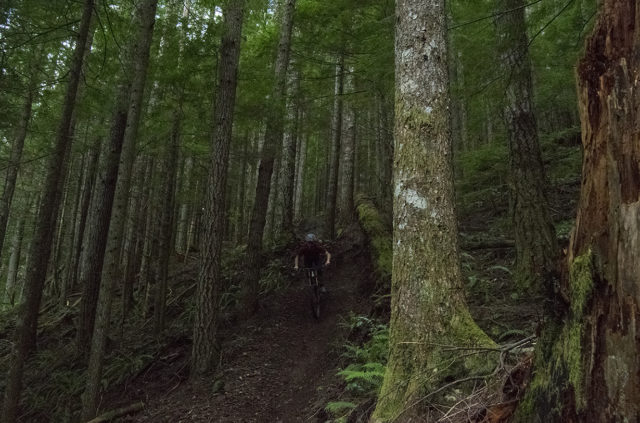
So, what’s the downside? For me, on this bike, not much. Yes, the steering feels a little less intuitive at really low speeds, but that’s not the G16’s strong suit no matter the fork offset. Reducing the offset by moving the stanchions relative to the steerer tube on a dual-crown fork does also reduce the turning radius a little, since the bumpers on the stanchions hit the frame slightly sooner. On the G16, which doesn’t have a particularly bulky headtube / downtube, this isn’t much of an issue either; on some frames with larger-diameter tubes (especially carbon ones) it might be more apparent.
The main thing I’d highlight though, is that I’ve found the reduced offset to be a significant improvement on the G16, despite the fact that it’s a bike that I mostly pedal to the tops of climbs, rather than shuttling or riding a chairlift. The downsides of a shorter-offset fork tend to show up at lower speeds (i.e. climbing), and the vast majority of bikes equipped with a Fox 40 fork are going to see far, far less of that than my G16 does. That’s not to say that a reduced-offset fork is going to be better on every bike and in every circumstance, but I’m firmly of the opinion that they are an improvement on bikes with long wheelbases and slack headtube angles that are focused primarily on descending well at speed. Most bikes that one would consider putting a 40 on fit that description.
Bottom Line
The Fox 40 fork has typically had offsets that have struck me – and clearly others, given the prevalence of the MORC 40 on World Cup DH race bikes last season – as too long for its intended use, and the MORC 40 is an impeccably made product that goes a long way to addressing that issue.
It doesn’t come cheap by any means, but is an excellent option for riders looking to fine-tune the handling on a bike equipped with a 40, especially those who’d like to be able to easily test the effects of changing offset first hand.

From the article: “The result is that a 2021 Fox 40 with the MORC crowns would have 33 or 38 mm of offset irrespective of wheel size.”
From the manufacturer website: “…on the newer style 40s from 2022 onwards they offer 42 and 37mm offsets”
I have a 2022 Fox 40 (29’r) with stock offset of 52mm. With the MORC crown, will I then have the option of 33 or 38…or 37 and 42?
Thanks for the catch. I just went back through my notes, and the 2021 27.5” 40 that I’d based those calculations off actually shipped from Fox with the 18 mm offset crowns (which produce 52 mm offset) rather than standard 14 mm crowns (48 mm total offset). I’d based the calculations off the assumption that the 2021 40 had the standard 48 mm offset that Fox states, so I was off by 4 mm here. Mojo has it right that the crowns give options for 37 or 42 mm offset on a 2021+ 40, irrespective of wheel size. I’ve updated the review to reflect that.
(The 40 chassis got updated for the 2021 model year, not 2022, so Mojo is a little off on that detail.)